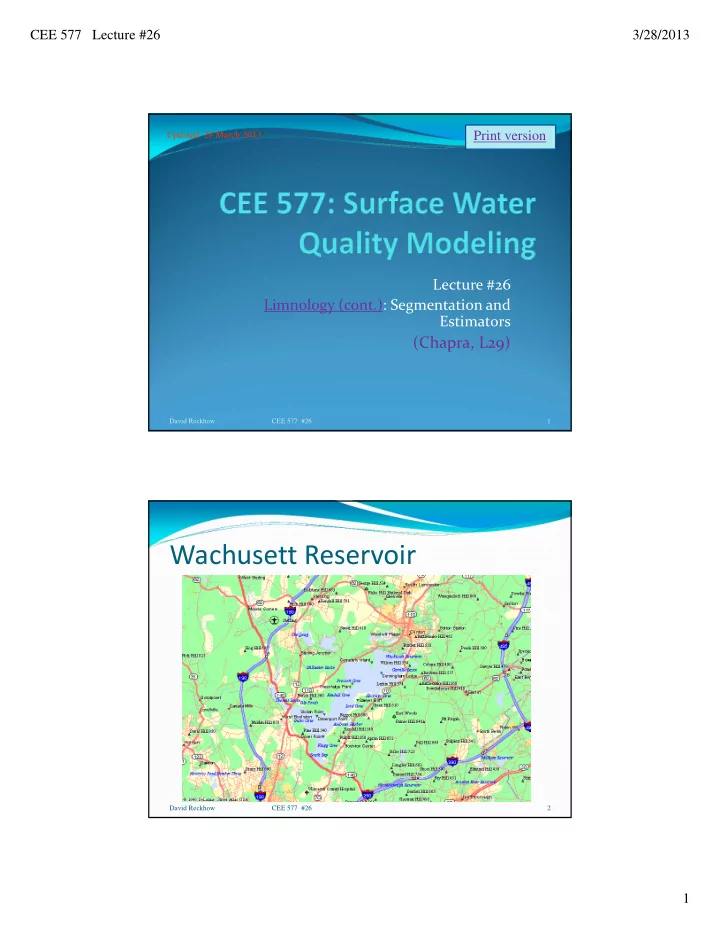

CEE 577 Lecture #26 3/28/2013 Print version Updated: 28 March 2013 Lecture #26 Limnology (cont.): Segmentation and Estimators (Chapra, L29) David Reckhow CEE 577 #26 1 Wachusett Reservoir David Reckhow CEE 577 #26 2 1
CEE 577 Lecture #26 3/28/2013 Wachusett Reservoir Segmentation: Surface David Reckhow CEE 577 #26 3 Wachusett Reservoir Segmentation: Depth David Reckhow CEE 577 #26 4 2
CEE 577 Lecture #26 3/28/2013 Atmosphere General Model K 2 (K a ) Kinetics K 4 4 SOD 1 Organic N K 1 (K s ) Dissolved Oxygen K 3 3 CBOD CBOD (K d ) 3 1 F NH 3 1 5 5 1 2 NO 2 Org-P 2 4 2 6 2 NO 3 Diss-P F ( 1 ) 1 3 4 2 1 Chlorophyll a (Algae) 1 David Reckhow CEE 577 #21 5 In ‐ lake Management Technique Notes 1 Dredging removal of sediments 2 Macrophyte Harvesting mechanical removal of plants 3 Biocidal Chemical chemicals added to inhibit growth of Treatment undesirable plants 4 Water Level Control flooding or drying of troublesome areas to control growths 5 Hypolimnetic Aeration or addition of oxygen, and mixing Destratification 6 Hypolimnetic Withdrawal removal of bottom waters low in oxygen and high in nutrients 7 Bottom Sealing/Sediment obstruction of the bottom by physical or Treatment chemical means 8 Nitrient Inactivation chemical precipitation or complexation of dissolved phosphorus, nitrogen, etc. 9 Dilution and Flushing increase flow to help "flush out" pollutants 10 Biomanipulation or Habitat encouragement of biological interactions to Management alter ecosystem processes David Reckhow CEE 577 #26 6 3
CEE 577 Lecture #26 3/28/2013 Watershed Management Technique Notes 1 Zoning/Land Use Planning Management of land use 2 Stormwater/Wastewater re-routing of wastewater flows Diversion 3 Detention Basin Use and increase time of travel for polluted waters so t Maintenance natural purification processes act 4 Sanitary Sewers installation of community-level collection syst 5 Maintenance and Upgrade of On- better operation & performance of home septi site Treatment Systems systems, etc. 6 Agricultural Best Management use of improved techniques in forestry, anima Practices crop science 7 Bank and slope stabilization erosion control to reduce sediment and associa loadings 8 Increased street sweeping frequent washing and removal of urban runoff contaminants 9 Behavioral Modifications a. use of Non-phosphate eliminates source of P detergents b. eliminate garbage grinders reduces general organic loading c. minimize lawn fertilization reduces nutrient loading d. restrict motorboat activity reduce turbulence and sediment resuspension e. eliminate illegal dumping reduce a wide range of conventional and toxic inputs David Reckhow CEE 577 #26 7 Forge Pond David Reckhow CEE 577 #26 8 4
CEE 577 Lecture #26 3/28/2013 Lake Morphometry Properties of Wachusett Reservoir & Forge Pond Property Symbol Units Wachusett Forge Pond m 3 2.5x10 8 3.33x10 5 Volume V km 2 Lake Surface SA 15.8 0.303 Area km 2 Watershed Area DA 295 37.7 Length L km 13.7 1.8 Length of L s km 59 5.94 Shoreline Maximum Width W km 1.8 0.45 Mean Width W km 1.2 0.12 Maximum Depth Z m m 39 2.2 Mean Depth Z m 15.6 0.9 m 3 /s Total Outflow Q 16 0.5 David Reckhow CEE 577 #26 9 Order of Magnitude Estimates Residence Time T=V/Q if T<100 d, stronger longitudinal gradients, greater productivity partly result of greater sediment and nutrient loads Drainage Area/ Lake Surface Area Ratio Watershed/Lake Management Approach Area Ratio < 10 In-lake measures may work by themselves. 10-50 In-lake measures are difficult, but may still work. Watershed management may be needed. > 50 In-lake measures are infeasible, watershed management is needed. David Reckhow CEE 577 #26 10 5
CEE 577 Lecture #26 3/28/2013 Order of Magnitude Estimates (cont.) Aspect Ratio AR=L/W <4, lateral gradients dominate use 2 ‐ d models? >4, longitudinal gradients dominate use 1 ‐ d or CSTR models Shoreline Development Ratio SDR L s 2 SA a measure of how dendritic a lake is, indicates potential for littoral productivity =1 for a perfectly circular lake =15 for a highly dendritic lake David Reckhow CEE 577 #26 11 Order of Magnitude Estimates (cont.) Relative Depth Z m RD= 50 SA comparison between depth and surface area. As ratio gets smaller there is a greater potential for wind to disrupt thermal stratification Areal Erosion SA exp Z AR= 1090 Z SA David Reckhow CEE 577 #26 12 6
CEE 577 Lecture #26 3/28/2013 Chemical Assessment N/P Ratio Nitrogen limited: <13:1 Algal cells ~ 16:1 Phosphorus limited >20:1 David Reckhow CEE 577 #26 13 To next lecture David Reckhow CEE 577 #26 14 7
Recommend
More recommend